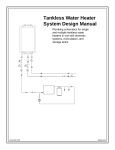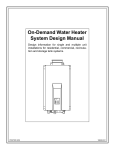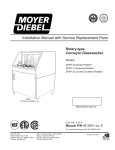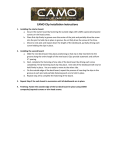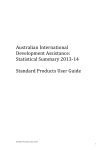Download Capital Stock User Guide
Transcript
UK Data Archive Study Number 6698 - Capital Stock Dataset, 1979 - 2005: Secure Data Service Access
Quick Guide for Users
Dataset:
Dates available:
Source:
Coverage:
Collected by:
Link fields:
Legal restrictions:
Capital Stock
1980-2001
Businesses
All sectors
ONS
dlink_ref2 (IDBR)
STA data
Quick summary:
The ARD has no capital stock information. The suite of programs above use industry investment data
and the ARD’s own capital expenditure figures to create an estimate of capital stock for each reporting
unit in each year 1980-2001. The estimates are calculated using the Permanent Inventory Method
(PIM). Separate depreciation rates are used for plant and machinery, vehicles and buildings but an
aggregate capital stock is reported.
The document building the capital stock_oct2002_02.pdf contains a description of the method,
particularly in respect of the treatment of missing values, initial codes and firm births. It also shows the
impact of some alternative assumptions.
The variables in the files are
year
siclett
all_def95
sel_idx
rcapstk95
dlink_ref2
year of observation
2-letter sic92
average investment deflator (average over p&m,. buildings and vehicles)
sel_idx=1 if capital stock could be computed for reporting unit
estimate of real capital stock with 1995 base year
reporting unit identifier
Sampling frame
The unit is the reporting unit from the ARD. In its current form, the data is available from 1980-2001.
Organisation of files:
Files are created as capstock_xx.dta in the cap_stock folder of the data drive. The xx relates to the
depreciation level on plant and machinery. As there is some dispute about the appropriate rate to use,
various datasets have been created.
All years and sectors are aggregated into one file.
Known data issues:
A change in the statistical treatment of leasing investment around 1988 occurred, but this seems not to
have had any impact on the estimates.
Disinvestment is taken as evidence of prior investment when allocating initial shares. This may lead to
a disproportionately high share of initial capital being allocated to declining or restructuring businesses.
Other issues
Investigation of 1970’s characteristics needs to be carried out.
Virtual Micro Data Laboratory
Technical Guide: Estimating capital stock
Robert Gilhooly
The Office for National Statistics (ONS) does not ask firms what their capital stocks
are; hence, it is necessary to construct capital stock series and then link these to the
other confidential data sets held within the Virtual Microdata Laboratory (VML). This
technical guide is designed to be used in conjunction with the syntax file (.do) which
created the capital stock data set. It provides a step-by-step guide to the key stages as
set out in the syntax file, and follows the same ordering to aid understanding.
The Microdata Analysis & User Support (MAUS) team has recently made a new
version of the Capital Stock data set available within the VML. It spans the years
1979-2005, and creates a firm-level estimate of capital stock for approximately
42,000 enterprises. This data set contains methodological improvements compared to
previous versions, and, specifically, addresses the negative capital stock series which
occurred in previous constructions of the data set.
The major development in the latest version of the capital stock data set is the ability
for users to tailor the data set for their own purposes. The syntax file available within
the VML has been designed to be very flexible; users can now easily create their own
capital stock estimates by selecting from a range of key variables & methods, and rerunning the file in their own work area. For example, by selecting a higher tolerance
ratio of imputed to real investment figures, a user can significantly expand the number
of enterprises for which a capital stock series are calculated.
This Technical Guide is intended to serve as a guide to the construction of the capital
stock data set. It covers:
• The data sets used
• Dealing with missing values and imputation techniques
• Allocation of the aggregate capital stock series to firms’ first appearance
• The Perpetual Inventory Model (PIM)
• Addressing negative capital stock series and injecting capital
The capital stock data set is unlike the majority of the other data sets held in the VML
because it is a “constructed” data set. Therefore there are many decisions needed to
overcome the issues outlined above, and there is not a definitive approach to take. The
user of this data set is advised to read this document and then decide whether to use
the file as it stands or adjust it using the options outlined.
1. Data sets
The capital stock data set is constructed from the Annual Respondents Database Panel
Data (ARDPD) set, which is itself constructed from the Annual Respondents
Database (ARD)1. The ARD holds firms’ responses to the Annual Business Inquiry
(ABI), while the MAUS team does some work on the raw ABI files to ensure that
there is longitudinal consistency in variables and firm reference numbers.
The ABI is the most comprehensive business survey conducted by ONS and covers
over 100 key economic variables, such as: turnover; production and operation costs;
employment: industry classification, and investment. The ABI has surveyed all
sectors since 1997, while firms in the manufacturing and construction sectors returned
questionnaires in from 1973 and 1994 respectively. It is a census of large businesses,
and a stratified sample of small and medium sized enterprises. The stratified sampling
framework means that smaller firms move in and out of the survey, and to create
capital stock estimates it is necessary to have a panel which accounts for such
“missing years”. The ARDPD solves this problem by creating entries for firms when
they do not appear in the ARD, but are still trading e.g. if a firm is in the ARD in
1997 and 2000, the ARDPD ensures it is present for 1998 and 1999 also. This process
creates a lot of missing values which must be imputed – in the previous example we
would not have any investment figures for 1998 and 1999 to feed into the PIM – and
section 2 outlines the approach we have taken to address this issue.
To create a PIM it is necessary to allocate shares of the aggregate capital stock series
to firms for the first year that they appear in the survey (basically, the PIM depreciates
this value, adds the net investment the following year and repeats these steps for all
years). The aggregate capital stock series used is the Volume in Capital Services
(VICS)2. Capital services are a flow measure which reflects the input of capital into
production; thus, are more suitable for analysing productivity than the National
Accounts wealth estimates of capital stock. The main difference between the National
Accounts measure of capital stock and the capital services estimate is how the net
stock estimates are weighted. Capital stocks are weighted using asset purchase prices
while capital services are weighted using asset rental prices. The rental price is
sometimes referred to as the user cost of capital, and it captures three components:
depreciation of the asset, nominal rate of return and the change in the purchase price
of the asset. If a firm is to rent an asset, the lease price must cover the loss in asset
value due to depreciation; the more an asset depreciates the greater its rental price.
Asset prices also affect the rental price as such movements reflect a capital gain or
loss for the owner. Similar to previous, a declining asset price must be covered by a
higher rental price to compensate the owner. Both of these key components can be
illustrated by ICT assets. Prices of ICT goods continue to fall sharply, and a capital
stock measure would result in such good being given less weight; however, this
1
Detailed information about the data sets held in the VML can be found at:
http://www.ons.gov.uk/about/who-we-are/our-services/vml/about-the-vml/datasets-available/datasetdownloads/index.html
2
More information about VICS can be found at:
http://www.statistics.gov.uk/StatBase/Product.asp?vlnk=14205&Pos=&ColRank=2&Rank=1000
implies a rising rental price and a capital services measure would give such assets a
higher weight. As noted by Wallis & Dey-Chowdhury (2007), there is a divergence
between the volume of capital service and volume of capital stock series after 1980,
which becomes increasingly stark after 1990. This divergence is caused by the move
towards short-lived and more productive assets, such as computers, for which the flow
of capital services is high. The standard capital stock measure does not capture this
shift and so understates growth in the productive input of capital in the UK economy.
A real firm level capital stock series is constructed by MAUS using deflators to adjust
for price changes in asset values over time. Deflators are constructed by SIC letter and
asset type for each year, using 1995 as the base. The deflators are then applied to the
investment figures (net capital expenditure) for each asset before they are used in the
PIM. Real input and output series are required to remove price affects and reveal
changes to firms’ production efficiency.
2. Missing values and imputation techniques
Some of the most important decisions to make in the construction of the capital stock
data set are with regards to the treatment of missing cell values, and the cleaning of
the data set before the PIM is run. There are many different approaches that we could
take to this problem, and this section outlines how MAUS have chosen to impute cell
values.
Employment is used as the spine for many of the imputations, plus the allocation of
the aggregate capital share, thus the first stage is to ensure that we have a complete
employment series. Generally, we can be confident using employment as this
information is available from the Inter-Departmental Business Register (IDBR);
hence, even if a firm does not respond to the questions in the ABI survey we are likely
to have an employment figure. When a cell value is missing between years we simply
interpolate the value. Missing (usually coded 0) cell values are more common in the
first years of a company’s existence, and these are filled in rolling back a three-year
average of the employment figures available. This is illustrated in the table below:
Year
1980
1981
1982
1983
1984
1985
1986
1987
1988
1989
1990
Original cells
Employment
0
0
0
100
120
120
114
150
170
165
Final cells
Adjusted Employment
108
111
113
100
120
120
114
132
150
170
165
We require a complete series of asset investment figures to compute the PIM and
must also impute these missing values. The investment series in the ARD are net
capital expenditure (capex) by asset. It is worth repeating that these figures are net i.e.
acquisitions minus disposals. While we do ultimately require the net investment figure
for PIM, the volatile nature of firm investment and missing values provide a challenge
for imputation – we are put further into the dark as acquisition and disposals series,
which might provide more information on underlying investment patterns, are not
available. The following graphs illustrate the problems we face:
35000
30000
25000
imputed 1
20000
imputed 2
15000
imputed 3
10000
5000
0
-
-
1985
1986
10000 15000
1987
-
1988 1989
20000 25000
1990
1991
1992
The graph above shows 3 methods of imputing missing values (labeled “-“; while the
figures on the x-axis represent real values e.g. 15,000 for 1988) for a firm which has
four positive net capex cells from 1985 to 1992. Imputation 1 interpolates the 1989
value and provides a constant extrapolation at the edges (1985, 1986 & 1992)3.
Imputation 2 also interpolates, but provides momentum extrapolation at the edges.
Imputation 3 creates an average capex figure over the real values and then uses this
number to fill-in the missing cells. At this stage, the three capex series already paint
different pictures, which will impact on the estimated capital stock series produced by
the PIM. It is critical to stress the importance of the net position i.e. negative values
are likely.4 The graph below shows what happens to the imputed series when net
capex becomes negative in some years:
40000
30000
20000
imputed 1
imputed 2
10000
imputed 3
-20000
1985 1986 1987
1988 1989
-
-6000
-17000
-
13000
20000
-10000
-
-
0
1990 1991 1992
The capex values given above are typical of the values we see in the microdata, and
reflect the volatile nature of firm investment patterns. The firm shown above is a net
investor (+10k) over the four years for which we have data; it is not clear which
3
This technique is used in Martin (2003).
The use of net investment partially counters criticism of constructing capital stock estimates at the
Reporting Unit level i.e. firms which close local units should report a negative investment. However, as
illustrated by Harris (2005), firms will not be allocated additional capital when they acquire new local
units. This is another reason why the capital stock series may underestimate the true figures.
4
imputation technique (if any) could be deemed to be “best” given the volatile nature
of firm investment. Methods 1 and 2 give strong investment figures, but the true
values could equally be negative. It should be noted that (almost) all imputation
techniques will smooth the estimated investment patterns below the volatile true
series which we would see if we had the real investment figures for the missing years.
The MAUS team decided to use the employment series to help with the imputation of
capex. It is hoped that this gives the estimated capex figures more real information
compared to just using one of the techniques outlined above. The latest capital stock
data set thus creates a capex series which inputes using an average of net capital
expenditure per employee for the real data, and then applies this to the missing values.
This is similar to imputation method 3 above, and while it produces low investment
figures for missing years it does ensure some consistency in the net position i.e. net
(positive) investors continue to invest over the years. This technique is increasingly
valuable in highly volatile series, where the other methods often impute large negative
figures. The table and graph below illustrate the imputation for a firm which is a net
investor for the four years which we have real data.
year
capex
1985
1986
1987
1988
1989
1990
1991
1992
Averages
employment
100
145
200
190
250
200
190
230
195
Average capex
per employee
20000
13000
-17000
-6000
2500
Imputed
1282
1859
20000
13000
3205
-17000
-6000
2949
n/a
13
25000
300
20000
250
15000
10000
200
5000
150
-15000
-20000
employment
-
-6000
-17000
-
13000
-10000
20000
-5000
-
-
0
Imputed
1985 1986 1987 1988 1989 1990 1991 1992
100
50
0
While it is possible to impute for any number of missing values the quality of the
imputation will suffer when we have fewer real values to base our calculations on (i.e.
we are likely to impute disposals of capital for all years for some firms). In practice, it
is prudent to set a tolerance level. Currently the maximum ratio of imputed to real
values is set at a maximum of 1:1. Lowering our intolerance to imputed values will
create estimates of firm capital stock for many more firms, and is likely to pick-up
more SMEs due to the stratified sampling framework within the ABI. The table below
outlines the number of firms for which we calculate capital stock given different
tolerance levels. Users can easily alter the “calc_ratio” in the syntax file and re-run to
suit their needs.
Calc_ratio
Tolerance level (max number of
imputed to real values)
0.33
0.66
1
1.5
2
Number of firms with
capital stock series
1:3
2:3
1:1
3:2
2:1
13131
21809
41782
50622
74356
3. Allocating capital to firms
The first stage in the PIM is to calculate the share of total industry capital which
should be allocated to the firms in your sample. We do this by assuming that the ratio
of firms’ investment (i.e. sum of individual firms’ investment) to industry investment
corresponds to their share of industry capital. The calculation of the initial capital
allocation is not precise, and allocating firms too little capital is one reason for the
implausible generation of negative capital stock series (see section 5). It seems
plausible that the stratified sampling framework of the ABI/ARD results in too low an
allocation of industry capital. The largest firms – presumably with most capital –
represent a disproportionate number of the firms in the microdata. The formulae for
the first stage of capital stock allocation is given by:
Allocation firm Capital(asset ) = Industry Capital(asset ) * Firm Investment Share(asset )
Firm Investment Share(asset ) =
∑ (rncapex)
year , siclett , asset
Industry Investment year ,siclett ,asset
Now that we have decided how much capital should be allocated to the firms we are
interested in, the second step is to devise a method for splitting this capital amongst
the firms. At this junction we want to choose a variable which is plausibly related to
capital stock and is available for all the years. The main options are “total purchases”
and “materials & fuels” – both could be seen as proxies for the capital stock and firms
are asked these questions in all years. Alternatives, which are only available from
1997 onwards, include: “number of local units”, “Spending on Insurance” and
“Spending on Road Transport”. As noted above, the new flexible .do file allows users
to specify which variable they would like to use, and within this .do file there is
another .do file which compares the alternative options against the number of capital
stock series which are created and are negative. The capital stock data set created by
the MAUS team indicates that the best results, for all years, are obtained by
specifying the key variable to be “total purchases”. A basic allocation of firm level
capital can be created using:
⎡
⎤
m0 _Share = ⎢key var
⎥
key
var
∑
siclett, year ⎦
⎣
We shall refer to the basic formulae above as Method 0 (m0) in the syntax file.
Method 0 is only able to split capital at the level of SIC letters, which is another
reason why capital stock series may become negative. Consider firms in the same SIC
letter but different SIC codes (e.g. a1=Civil engineering, a2=plumbling):
Method
m0
m0
m0
m0
Firm #
1
2
3
4
Year
1998
1998
1998
1998
SIC
letter
a
a
a
a
SIC
code
a1
a1
a2
a2
total
purchases
20
20
50
100
Share of
capital
0.11
0.11
0.26
0.53
We can make an attempt to (partially) remedy this situation by using a more advanced
method of allocating capital to firms. We can weight the allocation of capital by both
Total Purchases and Employment (or an alternative variable). The formulae below
outline two alternative methods for creating a share measure:
⎡
⎤ ⎡∑ employmentsic 3d , year
⎤
m1_Share = ⎢totpurch
⎥∗⎢
⎥
totpurch
employment
∑
∑
sic 3 d, year ⎦ ⎣
siclett , year ⎦
⎣
⎡
⎤ ⎡∑ totpurchsic 3d , year
m2 _Share = ⎢employment
⎥∗⎢
employment
∑
sic 3 d, year ⎦ ⎣
⎣
⎤
⎥
totpurch
∑
siclett , year ⎦
The tables below illustrate how the 2 different methods create different shares
compared to the original methodology.
Method
m1
m1
m1
m1
Firm
#
1
2
3
4
SIC
letter
a
a
a
a
SIC
code
a1
a1
a2
a2
Total
purchases
20
20
50
100
Employment
50
25
200
500
Method
m2
m2
m2
m2
Firm
#
1
2
3
4
SIC
letter
a
a
a
a
SIC
code
a1
a1
a2
a2
Total
purchases
20
20
50
100
Employment
50
25
200
500
SIC
code:
TP
0.50
0.50
0.33
0.67
SIC
code:
Employ.
0.67
0.33
0.29
0.71
SIC code by
letter:
Employment
0.10
0.10
0.90
0.90
SIC code by
letter: Total
purchases
0.21
0.21
0.79
0.79
Share
of
capital
0.05
0.05
0.30
0.60
Share
of
capital
0.14
0.07
0.23
0.56
The flexible set-up of the capital stock syntax allows a user to specify which method
(m0, m1 or m2) they would like to use in their capital stock. Investigation by the
MAUS team indicates that Method 1 produces the best results. See table below:
Counts of the number of negative capital stock series created under different methods
method
All assets
Plant & Machinery
Vehicles
Buildings
m0_totpurch
229
173
1719
207
m0_matfuel
622
444
4888
943
m1_totpurch
216
164
1652
189
m1_matfuel
613
446
4719
853
m2_totpurch
293
220
2596
333
m2_matfuel
393
282
4525
689
This table illustrates one of the major problems in constructing the capital stock data
set. The volatility in the net investment figures results in over 10% of the capital stock
series for vehicles becoming negative. Obviously, it is impossible for a firm to hold a
negative stock of vehicles, and this points to a combination of the main problems: not
allocating enough initial capital; an inability to split capital at a detailed enough level;
imputation techniques failing to create a large enough investment to assets (e.g.
vehicles) when there are missing cell values; and, possibly, using too high a
depreciation rate.
In the current methodology, all firms are allocated a share of the aggregate capital
stock when they first enter the data set. The PIM which we specify also adds on the
firm’s investment which it undertakes in its first year. It could be argued that if an
investment figure is available we should just use that as the firm’s first year capital
stock; however, it seems highly probable that the firm was in existence before it is
picked up by the ABI survey, thus allocating a share of the aggregate capital stock
figure in its first year provides a proxy for a firm’s “pre-ABI” capital stock.
4.
Perpetual Inventory Model
After selecting your key variable (total purchases), methodology (capital share
allocations) and dealing with missing values, running the PIM is relatively
uncontentious. All that is left for the user to do is to select the depreciation rates they
would like to use. The MAUS team follow the depreciation rates set out by ONS:
Plant & Machinery 6%, Buildings 2%, Vehicles 20%. However, alternatives such as
those based on BEA estimates include: Plant & Machinery 13%, Buildings 2.5%,
Vehicles 25%.5
The PIM uses geometric depreciation as follows:
Firm Capital Stock asset,yeari = (Allocation firm Capitalasset * Firm Investment Shareasset ) + rncapex yeari
Firm Capital Stockasset,yeari+1 = [Firm Capital Stock asset,yeari*( 1 − asset depreciation] + rncapex yeari+1
Firm Total Capital Stock year = ∑ Firm capital asset
We choose to use geometric depreciation, because the asset price depreciation and
physical deterioration (age-efficiency profile) of the assets coincide.6
5
6
See Fraumeni (1997)
See ONS Productivity Handbook (2007)
5.
Dealing with the remaining negative capital stock series
Given that a negative capital stock series is impossible in reality, we can address this
problem by injecting additional capital at a firm level. This can be done by stipulating
that a firm’s capital stock must not go below zero, increasing the investment figures in
the proceeding years and then re-running the PIM. It is advisable to inject the capital
close to the year in which the capital stock turns negative; consider the huge capital
injection which would be required if a 20 year vehicles series turned negative in the
last year i.e. a -£1000 figure would need £87,000 (1000*[1/0.8]^20) injection in the
first year to ensure that an entirely positive series is created. For this reason we
localize the injection to at most three years previously:
{
}
Asset Investment Injection = ( negative capital stock )* ⎡ 1
^n⎤
⎢⎣ (1 − depreciation ) ⎥⎦
The table below illustrates how a firm’s vehicle stock may turn negative – assuming
20% depreciation – and how a localized injection of capital can ensure that stocks do
not fall below zero:
year
1980
1981
1982
1983
1984
1985
1986
1987
1988
1989
1990
net
capex_vehicles
10,000
12,000
-5,000
-2,000
20,000
40,000
-20,000
-50,000
20,000
5,000
5,000
Capital
allocation
50,000
0
0
0
0
0
0
0
0
0
0
capital stock
60,000
60,000
43,000
32,400
45,920
76,736
41,389
-16,889
6,489
10,191
13,153
adjusted
capex
10,000
12,000
-5,000
-2,000
52,986
40,000
-20,000
-50,000
20,000
5,000
5,000
adjusted capital
stock
60,000
60,000
43,000
32,400
78,906
103,125
62,500
0
20,000
21,000
21,800
In practice, the calculated capital stock series often becomes negative for many
observations within a series; hence, it is often necessary to run the above injection
several times. The current syntax file calls in the “localised_boost.do” file several
times in a row to deal with this problem.
Capital stock
Methodological and data Issues
1) Deflators for “poth”, “pcom” and “int” are aggregated with a simple mean. A
weighted mean should be more appropriate (We could use VICS investment as
weights)
2) Small reporting units are sampled on a random basis hence the ARD displays
missing values in those years in which small firms are not selected. In order to
avoid underestimating the accumulation of capital by small firms, before applying
the PIM, missing investment values are linearly interpolated.
This methodology implies that firms follow a smooth capital adjustment pattern
over time. Despite this assumption is in line with neoclassical investment models,
there is evidence that firms adjust their capital stocks in a lumpy manner.
Investment seems to occur in large and concentrated episodes. (Doms and Dunne,
1998 and Attanasio et Al, 2003). Worth investigating investment patterns to see if
assumption behind interpolations are correct? Worth considering alternative
methods (ie regressing missing investment)?
3) The sectoral capital stock produced for the construction of 2003 Volume Index of
Capital Services (Vaze, 2003) separates computer from plant and machinery and
apply the appropriate deflators and depreciation rates. Keeping computers
separate is quite important because: i) ICT assets have a shorter life-span than
other type of assets; ii) they are characterised by rapid fall in relative price due to
quality improvements (see Oulton and Srinivasan, 2003 and Tevlin and Whelan,
2000).
When constructing the capital stock at reporting unit level we loose this level of
detail. In fact, since in the reporting unit investment in plant&machinery includes
computer software and hardware, when entering VICS data, we aggregate the
sectoral information for plant and machinery (poth) with hardware (pcom) and
software (int) in order to make it consistent with the ARD information. As a
consequence, when running the PIM the capital stock for plant and machinery is
incorrectly depreciated and deflated. Worth investigating with the ABI team the
possibility of constructing separate investment data for computer?
4) Depreciation rates should be updated using the information available in VICS.xls.
An average depreciation rate for “poth”, “pcom” and “int” should be calculated
taking into account the relative importance of each asset. Furthermore,
depreciation rates should be kept with a split by asset and sector (current version
is split by assets only)
5) When constructing the initial capital stock at enterprise-level, the sectoral capital
stock is split among all reporting unit in sector j and year 1. Then, the investment
is added to the initial capital stock. This causes a double counting problem
because the investment in the initial year is already accounted for in the sectoral
capital stock. One way to solve this problem would be to lag the sectoral
investment and relative shares by one period:
K iajt = K aj (t −1) * ϕ aj (t −1) * γ ij (t −1) + I iajt
t=age=1
φ=share of sectoral capital stock to be assigned to selected sample
γ=share of selected sample capital stock to be assigned to the individual reporting
unit
6) At the end of the programme, the capital stock by asset is aggregated to obtain an
overall measure of capital stock: “rcapstk95”. When aggregating different assets
we should use appropriate weights (currently we just sum up the 3 measures of
capital stock by asset). According to Oulton and Srinivasan (2003), each asset
should be weighted according to its asset’s price.
Bibliography
Attanasio, O. P., L. Pacelli, I. Reduto dos Reis (2003) “Investment Patterns in UK
manufacturing Establishments”,
Doms, M. and T. Dunne (1998) “Capital Adjustment Patterns in Manufacturing Plants,
Review of Economic Dynamics”, n.1, 409-429
Oulton, N. and S. Srinivasan (2003) “Capital stocks, capital services, and depreciation: an
integrated framework”, Bank of England, Working Paper n.192
Tevlin, S. and K. Whelan (1999) “Explaining the Equipment Investment Boom of the
1990s”, Division of Research and Statistics, Federal Reserve Board, December 29,
mimeo.
Vaze, P. (2003) “Estimates of the volume of capital services”, Economic Trends, n.600
Construction of Capital stock
Description of programme
The construction of the capital stock involves the use of the following do-files:
1.prepare_deflators.do
2.make_row.do
3.pim.do
1. prepare_deflators.do
•
Input deflators from VICS.xls; these are implied deflators from historic investment series
calculated by the ONS for the construction of 2003 Volume Index of Capital Services (VICS). The
Volume Index of Capital Service measure the flow of capital services derived from all the capital
assets that exist in a sector (see Vaze, 2003).
Deflators are split by asset, industrial sector and year:
Assets:
b = Buildings
poth = Plant other (plant and machinery including purchased software and excluding hardware)
pcom = Computer hardware
v = Vehicles
int = Intangibles (dominated by own-account software, excluding purchased software)
Industrial sectors:
The industrial desaggregation is identical to the Supply Use Table (SUT)’s classification for Gross
Fixed Capital Formation with a breakdown of 36 industries (see information in VICS.xls for
details)
•
“poth”, “pcom” and “int” are averaged to create one asset type called “pm”, representing plant and
machinery assets. In fact, we need to aggregate the 3 assets in order to make VICS information
consistent with the enterprise-level information from the ARD.
•
•
•
If deflator is missing it is replaced with the average deflators across sectors by year;
Drop observations <1979
Finally create one file per asset type (each spit by sector and year):
b_def95.dta (deflator for buildings)
pm_def95.dta (deflator for plant and machinery)
v_def95.dta (deflator for vehicles)
2. make_row.do
Input sectoral net capital stock from VICS.xls. This is the capital stock net of geometric
depreciation estimated by the ONS for the construction of 2003 VICS. Net Capital Stock of an
asset is a wealth measure calculated summing up the past history of gross investment in that asset
in constant prices and subtracting estimated depreciation and retirements. Depreciation is what
must be spent to maintain the value o capital stock at the existing level.
•
•
•
•
“poth”, “pcom” and “int” are aggregated into one asset type called “pm”.
drop observation <1979
transform capital stock’s unit from millions to thousands pound to make it consistent with
ARD investment data (which are in thousands)
assign 0 if capital stock is negative (this is to avoid negative shares)
•
saved as “prabstock02.dta”
Siclett
•
ind_capstk95b
ind_capstk95pm
ind_capstk95v
Input sectoral investment in constant price from VICS.xls. This is the Gross Fixed Capital
Formation (GFCF) in 1995 prices used by the ONS for the construction of 2003 VICS. The GFCF
consists of resident producers' acquisitions less disposals on fixed capital assets (as above split by
asset type, industrial sector and year)
•
•
•
•
•
•
“poth”, “pcom” and “int” are aggregated into one asset type called “pm”.
drop values<1979
If invest is = 0 it is replaced with a missing value(zero values would not allow us to estimate
the sectoral share of capital stock to be assigned to the sample of selected reporting units later
on in the programme)
Missing values are linearly interpolated
Take absolute values of investment (this is to avoid negative shares)
Transform investment’s unit from millions to thousands pound
•
Save as prabinvest.dta
Siclett
•
Year
Year
ind_ invest95b
ind_invest 95pm
Ind_ invest 95v
Input reporting unit-level information from the ARD Standard Variables:
dlink_ref2
reporting unit reference number (key consistent over time based
on post 94 idbr_ref)
totpurch
total purchases of goods and services
ncapex
ncapex_pm
ncapex_b
ncapex_v
go
total net capital expenditure*
net capital expenditure* for plant and machinery
net capital expenditure* for land & buildings
net capital expenditure* for vehicles
Gross output (used for checks only)
employment figures held to sampled enterprises (used for
sel_emp
checks only)
*In this context “net capital expenditure” means acquisitions less disposal proceeds of fixed assets. It
excludes any allowances for depreciation. See “code&derivation” file for more details on capex variables.
•
ncapex_pm is not reliable; thus, it is replaced with a residual figure calculated from "total
net capital expenditures" as follows:
ncapex_pm=ncapex-(ncapex_b+ncapex_v)
“ncapex”, derived from total acquisition (q600 ABI) less disposal, includes land, buildings,
plant, machinery (hence computer hardware), purchased computer software, and computer
software developed by own staff (see ABI survey form for more detail). Consequently,
“ncapex_pm” represents an estimate for investment in plant and machinery, including
hardware and software.
•
Save as rpanel_cap.dta
•
Load the Register Panel dataset (reg_pan.dta). The Register Panel, which contains selected and
non selected reporting unit all in one file, allows us to identify and keep reporting units which are
always selected and those which are selected only in some years (hence drop units which are never
selected). In years in which the small enterprises aren’t selected we will interpolate the missing
investment values.
•
Merge Register Panel variables with Standard Variables (merge rpanel_cap.dta using dlink_ref2)
Keep following variables:
dlink_ref2
year
ncapex (renamed ncapex_all)
ncapex_pm
ncapex_b
ncapex_v
sel_id (marker which indicates if reporting unit was selected in a specific year)
sel_emp
go
totpurch
sic92
region
•
•
Correct wrong asset types in 1994 & 1998 by assigning missing values.
Create age variable =_n (this variable will be used to identify when the reporting unit enters the
dataset for the first time. This information is required when estimating the initial capital stock at
reporting unit level)
•
•
Create SIC92 with 2 digit from SIC92-4 digit
SIC 92-2 digit are converted into SUT classifications using “numlettlook_7” (See VICS.xls for
info). This conversion is necessary to make ARD industrial classification consistent with VICS
industrial classification.
•
Input deflators
• Create an average deflator across all assets (all_def95)
• Use deflators to create real investment at reporting unit level:
rncapex_all95=ncapex_all/all_def95
rncapex_b95= ncapex_b/b_def95
rncapex_pm95= ncapex_pm/pm_def95
rncapex_v95= ncapex_v/v_def95
•
Interpolate investment missing data (when missing at the edge take previous or first non missing)
and generate “rncapex_aa95_old” to distinguish original data from the interpolated one
“rncapex_aa95” (aa=asset)
•
In order to identify reliable interpolation and original values, generate sel_idx==1 if the maximum
number of interpolations per reporting unit are less than 6 and investment values (ncapex_all95)
are non-missing. This marker will be used at the end of the programme to restrict the calculation of
capital stocks to “reliable” investment figures only.
•
Input investment and capital stock data at sector level prabstock02.dta
•
Calculate the initial share of sectoral capital stock to be assigned to the sample of selected units
(from now on we will refer “selected” as selected by the survey and interpolated). In fact, since our
sample of units represent only a certain percentage of enterprises in the sector, we need to calculate
how much of the sectoral capital stock we need to allocate to our sample of units in each sector
(and year). We calculate this share using the following hypothesis:
Capital share of selected sample = Investment share of selected sample=
ϕ
Calculate the investment share of selected sample in every sector/year as a percentage of sectoral
investment in corresponding sector/year :
i=reporting unit
j=industrial sector
t=year
ϕ ajt
•
aa=asset
I=investment in real terms
∑I
= invest_inflator`aa’jt=
i∈ajt
iajt
I ajt
Calculate reporting unit’s share of initial capital stock:
This share is estimated assuming the following hypothesis:
Reporting unit’s initial capital share = Reporting unit’s average material share.
•
Calculate material share:
Pi = reporting unit purchase of goods and services (totpurch)
•
By year and sector, creates the sum of total purchases across all units:
sum_totpurchjjt =
•
(i )
if sel_ idx==1
Pjti
∑P
i∈ jt
ijt
Calculate reporting unit average material share (average across life span of the unit)
∑M
Mi =
•
i∈ jt
Reporting unit material share:
Mijt =
•
∑P
t∈i
ijt
T
Calculate reporting unit average material share relative to year- totals.
1
∑ M ijt
Mi
T t∈i
γijt = M = 1
∑
i
∑
∑ M ijt
i∈ jt
i∈ jt T t∈i
save as cappanel_raw
3.pim.do
•
Set local depreciation rates:
Local pm=0.06
•
Set depreciation rates by asset:
d_all=(pm+b+v)/3
d_pm=0.06
d_b=0,02
d_v=0.2
•
Generate empty capital stock at reporting unit level-> rcapstk_aa’95 -> Kijt
•
Estimate total capital stock to be assigned to the selected sample in each year/sector. This is
estimated multiplying VICS capital stock by the investment share of selected unit in corresponding
year/sector
rem_`aa’= ind_capstck95 aa’ * invest_inflator aa’
rem_`aa’= K ajt * ϕ ajt , make it equal to 0 if negative
•
Estimate initial capital stock at reporting unit level. This is obtained multiplying the capital stock
of all selected units in sector j and year t=age=1 (year in which the unit first appears in the sample)
by the average material share of the individual reporting unit, then adding the reporting unit’s
investment in same year
if t=age=1 & sel_idx=1
rcapstk_aa’95= rem aa’*mat_sh_av_sh+rncapex_aa’95
K iaj1 = K aj1 * ϕ aj1 * γ ij1 + I iaj1
•
Apply Perpetual Inventory Method for all years: capital stock in previous year less capital
consumption (depreciation) plus investment in current year
If sel_idx=1
K iajt = K iaj (t −1) * (1 − d a ) + I iajt
rcapstck_pm95 = net capital stock for plant and machinery (including comp. hardware & software)
rcapstk_b95= net capital stock for land and buildings
rcapstk_v95= net capital stock for vehicles
rcapstk95=rcapstck_pm95+rcapstk_b95+rcapstk_v95
save capstock_pm_dep’


















